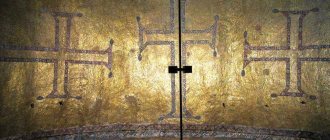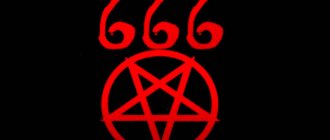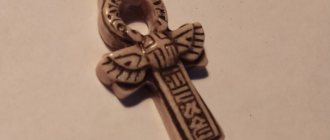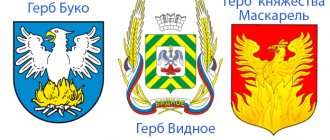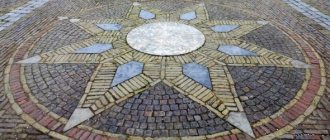An ordinary Catholic cross has four ends - the side parts are equal to each other, while the bottom is almost twice as long as the top. They are interpreted as follows: the top symbolizes God the Father, the side faces are the Holy Spirit and God the Son, the bottom part is Satan, over whom God has taken over. Hence the negative interpretation of the inverted cross as a symbol - in this position (180 degree rotation), Satan appears at the top, as if taking over the divine principle.
But this symbol has many other interpretations.
General symbolism of the cross
The first crosses appeared quite a long time ago. Even in pagan tribes, people began to use this symbolism independently of each other. It is noteworthy that they put approximately the same meaning into it: the unity of forces and the struggle of good with evil, light with darkness.
The first Christians rarely used the cross as their symbol, and the inverted cross entered culture generally in the fourth century AD, which is quite late compared to other signs. For example, svargs and Celtic crosses were known several centuries BC.
Today, these symbols are used in the mystical and occult sciences, to which both churches and various magical schools belong. And in each of them you can find an inverted cross with its own specific meaning.
So what does the cross of St. Peter mean?
The simplicity of drawing both types of cross itself suggests that the symbol appeared among different peoples, isolated from each other. They developed their ideas and in the end we get the same symbol with different meanings. This has always been the case – some perceived the sign positively, others – negatively. No one specifically wanted to invert the “ordinary” or, as it is called, “Latin” cross. It was originally like this among many nations.
Based on the above , we can conclude that we give all the meanings of symbolism ourselves. And it doesn’t matter what symbol you use or what faith you profess. It is much more important to remain a peace-loving person, not to harm others, to be provoked, and so on. It is not symbols that define a person, but his actions in relation to the world around him.
Apostle Peter
It’s not for nothing that we remembered this saint. According to legend, he was the first to turn over the famous Latin cross. Legend has it that in 65 AD, during the reign of Emperor Nero, Peter (as the first Pope) was sentenced to death.
The Apostle remembered how he denied his Teacher three times. Therefore, he considered it unworthy to die the same death. Peter asked to turn upside down the cross on which he was crucified.
This is how the inverted cross appeared, the meaning of which in those days was completely different than it is today. It symbolized man's true faith in Divine power and submission to the will of God. But this symbol was not used until the fourth century AD. And the classic Latin cross was banned. This is due to the fact that Christians were persecuted for a long time. Therefore, they tried not to advertise their faith, so as not to be executed.
What does a tattoo mean - an inverted cross on the face, forehead, arm?
But in tattoos, the symbolic meaning of an inverted cross does not have to be associated with Satan or Satanism, since in youth tattoo culture it can be completely different. For example:
- An inverted cross on a tattoo can have the same meaning as the symbol of a knight's sword and be associated with the traditions of chivalry.
- Means the Lorran Cross. According to legend, Joan of Arc, who came from the Lorran lands, had such a cross.
- An image in the form of an inverted cross on a tattoo can be a symbol of femininity, femininity, given the sketchy nature of the female figure in contrast to the male figure, which can be just as schematically depicted as an ordinary cross.
- Also in youth subcultures, an inverted cross can be associated with the Apostle Peter.
Inverted cross tattoo.
Everyone who decides to have a tattoo on their body in the form of an inverted cross and its various modifications puts their own specific symbolic meaning. It is safe to say that in tattoos the inverted cross and the interpretations of its symbolic meanings can be numerous and varied.
Pagan inverted cross
Contrary to the myth created by the Christian Church about the origin of the inverted cross, its image can be seen in the temples of Ancient Greece. He was a symbol of the god Apollo. Emperor Constantine, an admirer of this deity, also contributed to the spread of this symbol in Christianity. When Constantine decided to create and spread a religion that united peoples, this image appeared on the banners and shields of his army.
Among the Scandinavian peoples, an inverted cross is a symbol of the god Thor, namely his hammer. This is a powerful god who controlled lightning and could start or end a war.
Among the Slavs, this symbol meant unity with the forces of nature, as well as a sword pointing upward.
As you can see, this sign has a more ancient origin and means far from what we put into it today. Although the meaning of this cross depends on the teaching in which it is used.
Damage - an inverted red cross is painted on the door: what to do?
If someone finds an inverted cross painted on their door, and even in red paint, there is no need to sound the alarm and assume that damage has been caused. It’s quite possible that someone was acting up or just wanted to scare the owners. What is recommended to do in this case? Look carefully at what paint the image was made with.
If these are ordinary acrylic or oil paints, simply wash them off the door while reciting the Lord's Prayer. After the paint is washed off, sprinkle the door with holy water.
If it is paint mixed with wax, or the blood of an animal, then it is best to carry out some ritual to protect yourself. How?
- Go to the church and buy candles there.
- Try not to take change when buying candles.
- Give alms as you leave the church.
- Bless the door with burning church candles.
- Proceed to wash off the image on the door.
- Rinse the door with holy water while reciting the Lord's Prayer.
- Go into the house and take a shower. Leave your hair bare and loose.
- Walk through the apartment or house with a candle, hold the candle for a while in each corner, also reading a prayer.
- A few days later, repeat the ritual, starting with going to church. You need to do this three times.
If you find an inverted cross on your door, take measures to protect your home from evil forces. https://heaclub.ru/chto-oznachaet-perevernutyj-kres...nutyj-krasnyj-krest-chto-delat
Use in Christianity
The official Catholic Church recognizes the inverted cross as one of its symbols. Proof of this is his image on the throne of the Pope. At the same time, this fact causes ambiguous judgments in society.
Let's try to figure out what an inverted cross means for a Christian. The main task of a person on earth is to live a life in torment in order to find eternal bliss and peace. An ordinary Latin cross symbolizes the victory of life over death, good over evil, bliss over torment. The cross of Peter, in turn, signifies the impossibility of an ordinary person to repeat the feat of Christ. Therefore, he cannot be crucified on the cross. This means that all that remains for him is the humble expectation of eternal life, which symbolizes the cross upside down.
Oddly enough, most Christians have forgotten about this meaning and consider the cross of Peter to be a satanic sign, equal in power to the pentagram. Although a few centuries ago it was he who was the sign of the crusaders of the Knights Templar, who fought for the true faith against infidel pagans.
Use of the symbol in the 20th and 21st centuries
In the 20th century, Satanism from a group of religious sects turned into a subculture, far from religion, but replete with external paraphernalia. Along with inverted pentagrams, signs of Baphomet and goat heads, informals depicting Satanists also borrowed the cross of St. Peter. It gained popularity and was distributed throughout the world in the form of pendants, earrings, images on T-shirts and sweatshirts, which can be purchased almost everywhere.
Satanists began to use an inverted crucifix instead of an inverted cross, that is, a cross with the figure of the crucified Jesus Christ. While the cross of St. Peter was a fairly neutral symbol, an inverted crucifix for many means something anti-Christian, provocative.
In Catholicism, the cross of St. Peter is still used as one of the symbols of the Pope. In particular, the papal throne is decorated with such a cross.
In addition, various combinations of inverted crosses or crucifixes with inverted pentagrams, goat heads and other signs traditional for satanic cults are used. Such combinations do not carry any special meaning and are used rather as provocative external attributes.
Satanic practices
The usual Latin cross for Satanists has the following meaning: the upper part is God the Father, the sides are God the Son and God the Holy Spirit. The lower part symbolizes Satan, over whom all three hypostases of God have power. What does an inverted cross give? Its meaning changes dramatically - Satan becomes higher than God, which means he can lead him.
Black magicians say that it is not customary in their practices to create new symbols. Their magic is designed to transform, not create. Therefore, the magician cannot use the same symbols that are used in white magic. He must transform these symbols in such a way as to radically change the universe.
For such purposes, an “upside down” cross is ideal, denoting the world inside out, where heaven and earth, hell and heaven have changed places.
For this reason, the cross of Peter is often found in jewelry and on clothing of people who call themselves Satanists and Goths. These subcultures oppose themselves to public opinion, and therefore to the basic tenets of generally accepted religion along with its symbols.
The legend of the crucifixion of the Apostle Peter
The inverted cross owes its appearance in the bosom of the church to the legend of the Supreme Apostle Peter. To be more precise, this concerns his death, which, according to the same legend, took place in Rome in 65 or 67. According to Catholic doctrine, Peter was the head of the apostles and played the role of Christ's vicar on earth after the latter's ascension to heaven. Therefore, he went to Rome to preach the good news, to testify there about the Son of God before the emperor and the people of the eternal city. Having converted a considerable number of pagans and Jews there to Christianity, Peter thereby made enemies for himself among those who did not respond to his preaching. Among others, he was the then leader of the Roman Empire, Emperor Nero. There is a version that the latter disliked the apostle because he converted his two wives to Christ, who from that moment began to shun Nero. Whether this is true or not, Peter was put on trial and sentenced to death by crucifixion. The prince of the apostles had the opportunity to escape punishment. He even tried to take advantage of it by leaving Rome. Church legends say that on the way he met Jesus Christ heading towards Rome and asked him where he was going. Christ replied that he was going to Rome because Peter was fleeing from it. After this, the unlucky apostle went back to meet his fate.
When Peter was already prepared for execution, he asked the executioners to crucify him upside down, citing the fact that he was not worthy to be executed like his divine teacher. The Roman executioners fulfilled his request by turning over the cross to which the apostle was nailed. That is why it is known as the cross of St. Peter.
Context meaning
We tried to understand what an inverted cross means in different worldviews. As we can see, much in its interpretation depends on the context. If you look at it in isolation, then this cross is simply the intersection of two lines, two principles.
It is practically no different from a cuneiform bird or a pagan image of the sun. The masculine and feminine principles also intersect in it. And also this is the intersection of two paths. Its only difference from other types of ancient crosses is the disproportionate arrangement of intersecting straight lines.
For this reason, having taken a given symbol out of one context, we can easily place it in another, radically opposite in concept to the first. In addition, we can create a new value ourselves. All this is connected with the antiquity and complete ambiguity of the symbol, which is the cross of the Apostle Peter.
Is it possible to draw, embroider, wear an inverted cross: a T-shirt, a pendant, a tattoo?
An image of an inverted cross in any form, such as embroidered or as a print on clothing, like a tattoo or a pendant on the neck. Often, among young people who emphasize their belonging to a certain subculture and pose a certain challenge to traditional society, you can see an image of an inverted cross in the form of:
- embroidery
- print on clothes
- tattoo
- pendant, other
This is how a person seems to declare that he is not afraid of either the devil or the devil.
Inverted cross pendant.
It is unlikely that an adult, even an adherent of Satanism, will wear this kind of symbols on the street. Although, it must be said, there are brave souls who do not depend on public opinion and are not afraid of God's punishment. They boldly walk with the symbolism of an inverted cross, remaining original and independent. After all, it is just an image, not a creed. We also note that if designers who define fashion choose an inverted cross for their products, this symbol may well become leading and popular among fashion followers. This happened recently when the image of a skull and crossbones became trendy. It’s quite nice, and it’s unlikely that any of those who purchased products with similar images thought about the symbolism of death in them.
Print with an inverted cross on clothing.
Cross in the shape of the letter "T"
Anthony's cross
The cross, whose outline resembles the letter “T” (tau), is designated as the “tau-cross” or “Antonian cross” in honor of the venerable ascetic Anthony the Great, who, according to some information, lived for more than a hundred years (more precisely, 105). Anthony, who was born into a Coptic family, spent the last four decades near the Red Sea, leading the life of a hermit on Mount Kolzim. Previously, he refused the inheritance due to him, left by his parents, in favor of the poor residents of the area where he was born. In connection with his feat as a hermit, he is considered the founder of hermit monasticism.
A tau cross with a circle added on top is an ankh, or ankh. This symbol, also called the “handled cross,” “ansate,” and “cruxansata,” had very serious meaning among the ancient Egyptians. It combines two most important concepts: life, indicated precisely by the cross itself, and eternity, enclosed in a circle. The unification of life and eternity is the essence of immortality. Also, the combination of a circle and a cross meant the unification of the female and male hypostases. The Egyptians wore amulets with ankh to increase the duration of their earthly life, and they depicted it on funerary objects to ensure that the deceased would find eternal life in the other world. The ancient Egyptians imagined the key that opened the gates of the afterlife in the form of an ankh. Among the Copts, the early Christians of Egypt, the ankh was a symbol of the afterlife. In Egyptian hieroglyphs, this sign is interpreted as “life”, and is also included in the words “happiness” and “prosperity”. In the sixties of the last century, when the peace-loving hippie movement became popular, the ankh symbolized peace and truth.
"Greek" cross
Greek cross
The simplest form of the cross, which is similar to the mathematical “+” sign, is called the “Greek cross” (by the way, it is taken as the basis for the medical “Red Cross”). For many ancient peoples, this symbol meant the sun; it was often enclosed in a circle (a cross in a circle is called “solar”). The symbol of the sun is also a more complex swastika cross, with eight identical and broken ends, directed clockwise or counterclockwise. The reputation “damaged” by the fascists in no way detracts from its original positive meaning. The swastika was widely used in the culture of the ancient Aryans, Hindus and other peoples. Direction in one direction or the other distinguished, as one of the possible options, male and female symbols.
Orthodox Serbian cross
An Orthodox Serbian cross emerges from the base of a cross with identical components - only four stylized images of flint are added to it. The cross of the Egyptian Christians, the Copts, is also based on the "Greek" form. Each of its ends represents three rays, symbolizing the Holy Trinity. In general, the Greek cross has a lot of forms - these are the Maltese, the Hammer Cross (Potanian), and the Teutonic Crosslet, as well as many other configurations.
Georgian flag with Jerusalem cross
The Jerusalem cross on the Georgian flag is also basically Greek, only its ends resemble the letters “T”, and in the sectors there are four small crosses of a simple shape. On the attire of clergy of the Orthodox Church, the “Gammadion” is quite often found - a cross in the shape of the Greek letter “gamma”.
St. Andrew's cross
A cross with identical lines, rotated 45° and reminiscent of the letter X, by the way, the first in the name of Christ, is “St. Andrew’s”, named after the Apostle Andrew the First-Called. Saint Andrew, who was a fisherman, like his blood brother the Apostle Peter, was a disciple of Jesus. The Apostle Andrew witnessed the resurrection and ascension of Jesus and was, according to legend, crucified on a cross of exactly this shape in the Greek city of Patras.
Pre-Constantine monogram cross
St. Andrew's cross, crossed by one vertical line, carries information about the first letters of the Savior's name. The two Greek letters chi (X) and yot (I) when intersecting form the so-called “Pre-Constantinian” monogram cross. His image was found on one of the tombstones of the 3rd century AD, but was also found at a later time - for example, in Ravenna, on the Archbishop's Chapel built at the end of the 5th century. The St. Andrew's cross, which has one of the upper ends in the form of the same Greek letter "rho", is called the Konstantinovsky monogram.
Constantine monogram cross
According to legend, Tsar Constantine somehow received a sign: Christ appeared to him in a dream and, pointing to a cross shining in the sky, ordered it to be depicted on a banner to protect him from enemies. It looked like a combination of the letters “X” (chi) and “P” (rho), which are the first in the Greek spelling of the name of the Savior. The emperor did not limit himself to applying the monogram to the flags, but also ordered the minting of coins with its image.
There is a “sun-shaped” monogram - the image of the famous Konstantinovskaya is supplemented by a horizontal line crossing the junction of “X” and “P”. Its meaning is contained in the words from the Holy Scriptures, which indicate that the Lord God is the Sun and all believers will be healed in its rays when it rises. There is also a monogram based on the T-shape of a cross with a “rho” added on top, also symbolizing the Cross of Jesus and which spread to various places in Europe, sometimes in the 4th and sometimes in the 5th century AD.
Southern Cross constellation
The Southern Cross is the smallest constellation known to us. The ancient Greeks considered it part of the Centaur constellation, and it was separated into a separate one only at the beginning of the 17th century. The Southern Cross constellation is the main landmark in the Southern Hemisphere, like the North Star in the Northern Hemisphere. This constellation appears on the flags of Australia and New Zealand.
Brazilian Order of the Southern Cross
Southern Cross constellation. 17th century engraving
